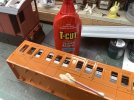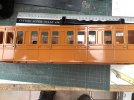Great idea but a warning about T Cut and similar paint cutting agents, like toothpaste, they are all mild abrasives that include other "contaminents", unlike very fine wet/dry abrasive sheet. First check that whatever you are removing is not under a laquer coating. Otherwise you need to go through that to get at what you want to remove and will have to match the original finish, check for compatibility and recoat partialy or entirely. You might as well use a 1200 grade wet/dry in those instances and accept you will have to do an all over recoat. Some LGB products have a semi matt texture in the molded finish and T Cut it will poloish this up to a shine - see my comment below about fixing glue blemishes.
Once you have finished using a product of this type make sure you remove every trace of it, and any other fine ground particulate residues, if you are going to (re)apply a painted/laquered surface - any residue, however small (in crevises, etc') or it will create a "crinkle" effect on anything applied over it. The other thing is it is very easy to go through a painted, rather than colour molded, surface and through to the unpainted substate below - like USAT, Aristocraft products and others. Use this method with great care and forethought.
One of the great uses for T Cut, apart from its intended purpose, is as a "plastic polish". Microscale market similar stuff, at an exorbitant price, for this purpose. It is also an aid, to finish off, as part of a process when you are trying to remove glue blemishes on transparent plastic parts like windows. Max
Edit - I found this report that tests T-Cut and other related paint renovating, mild abrasive, products. It might be of help here in the suggested applications
CarPlan T-Cut Scratch Remover | Auto Express






